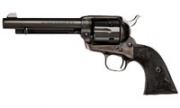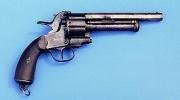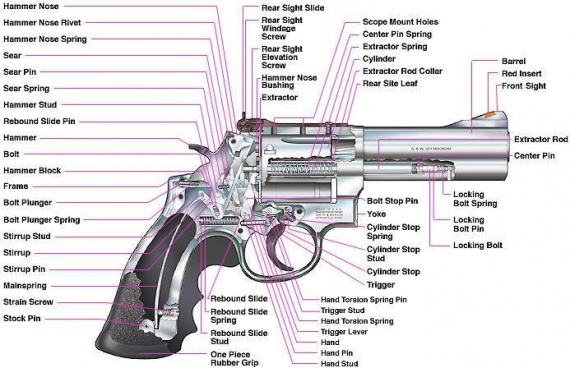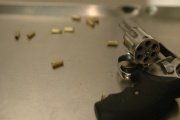Revolver

A revolver is a repeating firearm that consists of multiple chambers and at least one barrel for firing. As the user cocks the hammer, the cylinder revolves to align the next round with the barrel, which gives its name. In modern sense, a revolver refers to a handgun that has a revolving cylinder which typically chambers 5 or 6 rounds. However, other firearms and weapons may also have the design of a revolver, with notable examples being various grenade launchers and riot guns, and even some rifles.
Contents |
[edit] History
The first revolvers were partly an attempt to improve on pepper-box type weapons, which used a revolving cylinder with one set of firing mechanisms, but which had multiple barrels as well. Firing through a single barrel saved the expense and weight of having the multiple barrels of the pepper-box.
The earliest example of a revolver is a revolving arquebus, produced by Hans Stopler in 1597. Another early specimen, now in the Tower of London armories, is dated to the middle 1600s and attributed to John Dafte of London. This example, a flintlock, uses a single lock, with a flash pan for each of the six chambers. The cylinder is rotated by hand, and locks in place for firing. This was still not perfected, however, as it was apparently destroyed by a misfire.[1] James Puckle patented a revolving chamber gun in 1718. This gun, which had a 1.25 inch bore (30 mm) was tripod mounted, and the 11 shot cylinder was operated by a hand crank. It is often cited as the first machine gun. By changing cylinders to reload (an early example of a speedloader), the gun was fired and reloaded to fire a total of 63 rounds in 7 minutes.[2] Elisha Collier patented a flintlock revolver in Britain in 1818, and significant numbers were being produced in London by 1822.
In 1835, Samuel Colt patented a revolver mechanism that was to lead to the widespread use of the revolver. According to Samuel Colt, he came up with the idea for the revolver while at sea, inspired by the capstan winch, which had a ratchet and pawl mechanism on it, a version of which was used in his guns to rotate the cylinder. Revolvers proliferated largely due to Colt's ability as a salesman. Revolvers have remained popular to the present day in many areas, although in the military and law enforcement they have largely been supplanted by magazine-fed semi-automatic pistols such as the Colt M1911, especially in circumstances where reload time and higher cartridge capacity are important.
[edit] Overview
A revolver works by having several firing chambers arranged in a circle in a cylindrical block that are brought into alignment with the firing mechanism and barrel one at a time. A single action revolver requires the hammer to be pulled back by hand before each shot. In contrast, in a double action revolver, squeezing the trigger can pull back the hammer to cock the gun as well as serving to release the hammer. Most modern double action revolvers can also be fired in single action mode, which serves to improve the accuracy by reducing the force and distance required to pull the trigger. A few designs, however, have fully-concealed hammers and are double-action-only. Because the effort required to cock the hammer is part of the firing action in double action revolvers, they can generally be fired faster than a single action, but at the cost of reduced accuracy in the hands of most shooters.Most commonly, such guns have a 5 or 6 shot capacity (hence the more common names of 'six-gun' or 'six-shooter'); however, some revolvers have a 7, 8, 9, or 10 shot capacity (this often depends on the caliber, though different companies produce revolvers in the same calibers with different capacities, due to other design differences), and each chamber has to be reloaded manually. This makes the procedure of reloading such a weapon slow. The alternatives are a replaceable cylinder, a speedloader (manufactured by HKS and Safariland) which can reload all chambers at once, or a moon clip that holds a full load (or even half of one in the case of a half-moon clip) of ammunition and that is inserted along with the ammunition. Bianchi manufactures a product known as a "speedstrip". Speedstrips cannot reload a completely empty revolver as rapidly as a speedloader, but are less expensive, flatter, and more flexible when it comes to partial reloads.
Compared to autoloading handguns, a revolver is often simpler to operate (despite often being more mechanically complex) and may have greater reliability (depending on factors such as firmness of grip, ammunition or catridge used, and degree of maintenance and lubrication provided to the firearm). For example, should a semiautomatic pistol fail to fire, clearing the chamber requires manually cycling the action to remove the errant round, as cycling the action normally depends on the energy of a cartridge firing. With a revolver, this is not necessary as none of the energy for cycling the revolver comes from the firing of the cartridge, but is supplied by the user either through cocking the hammer or, in a double action design, by just squeezing the trigger.
Over the long period of development of the revolver, many calibers have been used. Some of these have proved more durable during periods of standardization and some have entered general public awareness. Among these are the .22 rimfire, a popular target shooting caliber; .38 Special and .357 Magnum, known for its police use; the .44 Magnum, famous from Clint Eastwood's "Dirty Harry" films; and the .45 Long Colt, used in the Colt revolver of the "Wild West". Introduced in 2003, the Smith & Wesson Model 500 is the most powerful production revolver ever created, using the .500 S&W Magnum round.

As revolvers are of a 19th-century design, it is not surprising that semi-automatic pistols have largely overtaken them in military and law enforcement applications. Their lower ammunition capacities and relatively longer reload times compared to autoloading pistols are the main reasons for the switchover that occurred in the 1980s and 1990s. Additionally, the flat profile of semi-automatics make them more suitable for concealed carry. Revolvers still remain popular in the role of back-up (and off-duty) guns among American law enforcement officers and security guards. Also, revolvers are still common in the American private sector as defensive and sporting/hunting firearms.
Famous police and military revolvers include the Webley, the Colt Single Action Army, the Smith & Wesson Model 29, the Smith & Wesson Model 10, and the Smith & Wesson 1917.
Revolver technology does live on in other weapons used by the military. Some autocannons and grenade launchers use mechanisms similar to revolvers, and some riot shotguns use spring loaded cylinders holding up to 12 rounds.
In addition to serving as backup guns, revolvers still fill the specialized niche role as a shield gun; law enforcement personnel operating a ballistic shield sometimes opt for a revolver instead of a self-loading pistol with a Gun shield, as the latter's slide may strike the front of the shield when fired; revolvers do not suffer from this disadvantage. A second revolver may be secured behind the shield to provide a quick means of continuity of fire.
[edit] Loading and unloading
[edit] Front loading
Often called muzzle loading, the first revolvers were more accurately described as front loading. Rather than being loaded through the barrel, each chamber in the cylinder was rotated out of line with the barrel, and charged from the front with loose powder and a bullet. Usually, there was a loading lever attached to the bottom of the barrel that gave the user leverage to force the oversized lead ball into the chamber, which sealed it and held the ball and powder securely in place. The first practical revolvers were caplocks or cap and ball revolvers, because the caplock method of priming was the first to be compact enough to make a practical revolver feasible.
[edit] Fixed cylinder designs
In many of the first generation of cartridge revolvers (especially those that were converted after manufacture), the pin on which the cylinder revolved was removed, and the cylinder taken from the gun for loading. Later models used a loading gate at the rear of the cylinder that allowed one cartridge at a time to be accessed for loading, while a rod under the barrel could be pressed backwards to extract the fired case. Most revolvers using this method of loading are single action revolvers.
The loading gate on the original Colt designs (and on nearly all single action revolvers since) is on the right side, which may favor left-handed users; with the revolver held in the proper grip for shooting in the left hand, the cartridges can easily be ejected and loaded with the right.[3]
Since the cylinder in these revolvers is firmly attached at the front and rear of the frame, and since the frame is typically full thickness all the way around, fixed cylinder revolvers are inherently strong designs. Because of this, many modern large caliber hunting revolvers tend to be based on the fixed cylinder design.
[edit] Top break

The next method used for loading and unloading cartridge revolvers was the top break design. In a top-break revolver, the frame is hinged at the bottom front of the cylinder. Releasing the lock and pushing the barrel down brings the cylinder up -- this exposes the rear of the cylinder for reloading. In most top-break revolvers, the act of pivoting the barrel and cylinder operates an extractor that pushes the cartridges in the chambers back far enough that they will fall free, or can be removed easily. Fresh rounds are then placed into the cylinder, either one at a time or all at once with either a speedloader or a moon clip. The barrel and cylinder are then rotated back and locked in place, and the revolver is ready to fire. Since the frame is in two parts, held together by a latch on the top rear of the cylinder, top-break revolvers are relatively weak, and cannot handle high pressure rounds. Top-break designs are nearly extinct in the world of firearms, but they are still found in airguns.
One of the most famous "break top" revolvers is the Schofield Model 3, designed in the late 19th century and used by western outlaw Jesse James. Another notable design is the Enfield and Webley series of revolvers used by the British Armed Forces from the 1880s through the 1960s.
[edit] Swing out cylinder
The last and most common method of loading and unloading is the swing out cylinder. The cylinder is mounted on a pivot that is coaxial with the chambers, and the cylinder swings out and down (to the left in most cases). An extractor is fitted, operated by a rod projecting from the front of the cylinder assembly. When pressed, it will push all fired rounds free simultaneously (as in top break models, the travel is designed to not completely extract longer, unfired rounds). The cylinder may then be loaded, singly or again with a speedloader, closed, and latched in place. The pivoting part that supports the cylinder is called the crane; it is the weak point of swing-out cylinder designs. Using the method often portrayed in movies and television of flipping the cylinder open and closed with a flick of the wrist can in fact cause the crane to bend over time, throwing the cylinder out of alignment with the barrel. Lack of alignment between chamber and barrel is a dangerous condition- impeding the bullet's transition from chamber to barrel. This gives rise to higher pressures in the chamber, bullet damage, and the potential for an explosion if the bullet becomes stuck. The shock of firing can also put a great deal of stress on the crane, as in most designs the cylinder is only held closed at one point, the rear of the cylinder. Stronger designs, such as the Ruger Super Redhawk, use a lock in the crane as well as the lock at the rear of the cylinder. This latch provides a more secure bond between cylinder and frame, and allows the use of larger, more powerful cartridges.
[edit] Action
[edit] Single action
In a single action revolver, the hammer is manually cocked, usually with the thumb of the firing or supporting hand. This action advances the cylinder to the next round and locks the cylinder in place with the chamber aligned with the barrel. The trigger, when pulled, releases the hammer, which fires the round in the chamber. To fire again, the hammer must be manually cocked again. This is called "single action" because the trigger only performs a single action, of releasing the hammer. Because only a single action is performed and trigger pull is lightened, firing a revolver in this way allows most shooters to achieve greater accuracy. Additionally, the need to manually cock the hammer acts as a safety. It is noted that a single action system can fail during a crucial attempt unless operated by an expert hand.
[edit] Double action
Most double action revolvers may be fired in two ways. The first way is exactly the same as a single action revolver; the hammer is cocked, which advances the cylinder counter-clockwise when viewed from the rear, and when the trigger is pulled, this releases the hammer. Double action revolvers also can be fired from a hammer down position, by pulling the trigger. In this case, the trigger first cocks the hammer (thus advancing the cylinder counterclockwise or clockwise, depending on the gun's manufacturer) and then releases the hammer at the rear of its travel, firing the round in the chamber. Certain revolvers, called double action only, lack the latch that enables the hammer to be locked to the rear, and thus can only be fired in the double action mode. With no way to lock the hammer back, double action only designs tend to have bobbed or spurless hammers, and may even have the hammer completely covered by the revolver's frame. These are generally intended for concealed carrying, where a hammer spur could snag when the revolver is drawn. The potential reduction in accuracy in aimed fire is offset by the increased capability for concealment.
[edit] Other
Iver Johnson made an unusual model from 1940 to 1947, called the Trigger Cocking Double Action. If the hammer was down, pulling the trigger would cock the hammer; if the trigger was pulled with the hammer cocked, it would then fire. This meant that to fire the revolver from a hammer down state, the trigger must be pulled twice.[4]
[edit] Use with suppressors
As a general rule, revolvers cannot be equipped with a sound suppressor, as there is usually a small gap between the revolving cylinder and the barrel over which a bullet must traverse or jump when fired. From this opening, a rather loud report is produced even when a suppressor is installed on the end of the barrel of most revolvers. However, eliminating this problem would make the revolver an ideal weapon for suppressed use: in automatics, the action itself creates a significant amount of noise even if muzzle report is totally eliminated. A revolver, which does not cycle on its own and whose action is naturally quiet, does not present this problem.
Nonetheless, a suppressible revolver design does exist in the Nagant M1895, a Russian military revolver used from 1895 through World War II. This revolver uses a unique cartridge that extends beyond the end of the bullet, and a cylinder that moves forward to place the end of the cartridge inside the barrel when ready to fire. This bridges the gap between the cylinder and the barrel, and expands to seal the gap when fired. While the tiny gap between cylinder and barrel on most revolvers is insignificant to the internal ballistics, the seal is especially effective when used with a suppressor, and a number of suppressed Nagant revolvers have been used since its invention.[5]
There also exists a modern revolver of Russian design, the OTs-38,[6] which uses ammunition that incorporates the silencing mechanism into the cartridge case, making the gap between cylinder and barrel irrelevant as far the suppression issue is concerned. The OTs-38 does need an unusually close and precise fit between the cylinder and barrel due to the shape of bullet in the special ammunition (Soviet SP-4), which was originally designed for use in a semi-automatic.
[edit] Automatic revolvers
- main article: Automatic revolver
Double action revolvers use a long trigger pull to cock the hammer, thus negating the need to manually cock the hammer between shots. The disadvantage of this is the long, heavy pull that cocks the hammer makes the double action revolver much harder to shoot accurately than a single action revolver (although cocking the hammer of a double action reduces the length and weight of the trigger pull). There is a rare class of revolvers, the automatic revolver, that attempts to overcome this restriction, giving the high speed of a double action with the trigger effort of a single action.
The Webley-Fosbery Automatic Revolver was the first commercial example, introduced in 1901. It was recoil-operated, and the cylinder and barrel recoiled backwards to cock the hammer and revolve the cylinder. It was distinctive in that cam grooves were milled on the outside of the cylinder to provide a means of advancing to the next chamber--half a turn as the cylinder moved back, and half a turn as it moved forward. .38 caliber versions held 8 shots, .455 caliber versions 6. At the time, the few available automatic pistols were larger, less reliable, and more expensive. The automatic revolver was popular when it first came out, but was quickly superseded by the creation of reliable, inexpensive semi-automatic pistols.
In 1997, the Mateba company developed a type of recoil-operated automatic revolver, commercially named the Mateba Autorevolver, which uses the recoil energy to auto-rotate a normal revolver cylinder holding 6 or 7 cartridges, depending on the model. The company has made several versions of its Autorevolver, including longer barrelled and carbine variations, chambered for .357 Magnum, .44 Magnum and .454 Casull. The Pancor Jackhammer is a combat shotgun based on a similar mechanism to an automatic revolver. It uses a gas action to move the barrel forward (which unlocks it from the cylinder) and then rotate the cylinder and cock the hammer.
[edit] Patents
Elisha Collier patented a flintlock revolver in Britain in 1818, and significant numbers were being produced in London by 1822. The origination of this invention is in doubt, as similar designs were patented in the same year by Artemus Wheeler in the United States and by Cornelius Coolidge in France.
Samuel Colt received a British patent for his revolver in 1835 and an American patent (number 138) on February 25, 1836 for a Revolving gun, and made the first production model on March 5 of that year.
Another revolver patent was issued to Samuel Colt on August 29, 1839. The February 25, 1836 patent was then reissued as U.S. Patent RE00,124 entitled Revolving gun to Samuel Colt on October 24, 1848. This was followed by US Patent 0,007,613 on September 3, 1850 for a Revolver, and by U.S. Patent 0,007,629 on September 10, 1850 for a Revolver.
US Patent 5333531 was issued to Roger Field for an economical device for minimizing the flash gap of a revolver between the barrel and the cylinder.
[edit] Famous brands and manufacturers
[edit] See also
- List of handgun cartridges
- List of cartridges by caliber
- Pistol
- Colt Diamondback
- Colt Python
- Colt Anaconda
- Smith & Wesson Model 686
- Rat-shot
- Russian roulette
- Revolver cannon
- Table of cartridges by year
- Antique guns
[edit] References
- ↑ Samuel Colt (1855). On the Application of Machinery to the Manufacture of Rotating Chambered-Breech Fire-Arms, and Their Peculiarities. W. Clowes.
- ↑ See main article, James Puckle
- ↑ Tips For Lefties Shooting In a Right Handed World R.K. Campbell, GunWeek.com
- ↑ S. P. Fjestad (1992). Blue Book of Gun Values, 13th Ed., Blue Book Publications, Inc.. ISBN 0-9625943-4-2.
- ↑ Silenced 7.62 mm Nagant Revolver
- ↑ Modern Firearms - OTs-38 silent revolver
[edit] Gallery
Colt Anaconda .44 Magnum revolver
Colt New Service revolver
Colt Python .357 Magnum revolvers
Smith & Wesson Model 686 .357 Magnum revolvers
Smith & Wesson Model 625 for IPSC shooting
[edit] External links
- The Snubnose Files
- How Stuff Works - Revolver
- U.S. Patent RE124 -- Revolving gun
- U.S. Patent 1,304 -- Improvement in firearms
- U.S. Patent 7,613 -- Revolver
- U.S. Patent 7,629 -- Revolver








